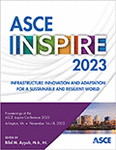Measuring Inequities in Post-Disaster Accessibility to Schools
Publication: ASCE Inspire 2023
ABSTRACT
With Justice40, the infrastructure bill, and other recent national policies, researchers and practitioners are exploring ways to approach community resilience through an equity lens. To operationalize a social equity-oriented paradigm, predictive tools and frameworks are needed to assess the uneven spatial distribution of disaster social impacts across a community. Arguing that schools are social institutions fulfilling a community’s social needs through educational services, this paper proposes a framework for measuring changes in accessibility to schools during and after disasters. The accessibility is quantified using a temporally based metric that evaluates access from four dimensions: proximity, availability, adequacy, and acceptability. The framework proxies the existing disparities among community members by estimating a social vulnerability value for each household. Considering accessibility and social vulnerability together, the framework enables resilience planners to forecast possible inequities in post-disaster accessibility to schools and address them in the community’s preparation, hazard mitigation, and disaster recovery plans.
Get full access to this article
View all available purchase options and get full access to this chapter.
REFERENCES
Burton, C., Rufat, S., and Tate, E. 2018. Social Vulnerability: Conceptual Foundations and Geospatial Modeling.
Cutter, S. L., Boruff, B. J., and Shirley, W. L. 2003. “Social Vulnerability to Environmental Hazards*.” Social Science Quarterly, 84(2), 242–261, https://doi.org/10.1111/1540-6237.8402002.
Drakes, O., Tate, E., Rainey, J., and Brody, S. 2021. “Social vulnerability and short-term disaster assistance in the United States.” International Journal of Disaster Risk Reduction, 53, 102010, https://doi.org/10.1016/j.ijdrr.2020.102010.
Dunning, M., and Durden, S. 2011. Social Vulnerability Analysis Methods for Corps Planning. U. S. A. I. f. W. Resources, ed., US Army Corps of Engineers.
Enderami, S. A. 2022. Functionality, Access, and Implications: Assessing the Role of Organizations in Community Disaster Resilience.Ph.D., University of Kansas, United States.
Enderami, S. A., and Sutley, E. J. 2022. “Social Vulnerability Score: a Scalable Index for Representing Social Vulnerability in Virtual Community Resilience Testbeds.” Natural Hazards, PREPRINT (Version 1) available at Research Square, https://doi.org/10.21203/rs.3.rs-2113725/v1.
Enderami, S. A., Sutley, E. J., and Hofmeyer, S. L. 2021. “Defining organizational functionality for evaluation of post-disaster community resilience.” Sustain Resilient Infrastruct, 1–18, https://doi.org/10.1080/23789689.2021.1980300.
Flanagan, B. E., Gregory, E. W., Hallisey, E. J., Heitgerd, J. L., and Lewis, B. 2011. “A social vulnerability index for disaster management.” Journal of homeland security and emergency management, 8(1).
Great Schools Partnership, Education Writers Association, and Nellie Mae Education Foundationcite. 2014. “Glossary of Education Reform.” Accessed October, 2022. <https://www.edglossary.org/>.
Hendricks, M. D., and Van Zandt, S. 2021. “Unequal Protection Revisited: Planning for Environmental Justice, Hazard Vulnerability, and Critical Infrastructure in Communities of Color.” Environmental Justice, 14(2), 87–97, https://doi.org/10.1089/env.2020.0054.
Kamel, N. M. O., and Loukaitou-Sideris, A. 2004. “Residential Assistance and Recovery Following the Northridge Earthquake.” Urban Studies, 41(3), 533–562.
Liu, D., and Li, Y. 2015. “Social vulnerability of rural households to flood hazards in western mountainous regions of Henan province, China.” Nat. Hazards Earth Syst. Sci. Discuss, 3, 6727–6744.
NCES (National Center for Education Statistics). 2016. “School Attendance Boundary Survey (SABS).” Accessed October, 2022. <https://nces.ed.gov/programs/edge/SABS>.
NRC (National Research Council). 2006. Facing Hazards and Disasters: Understanding Human Dimensions, The National Academies Press, Washington, DC.
Nofal, O. M., and van de Lindt, J. W. 2020. “High-resolution approach to quantify the impact of building-level flood risk mitigation and adaptation measures on flood losses at the community-level.” International Journal of Disaster Risk Reduction, 51, 101903, https://doi.org/10.1016/j.ijdrr.2020.101903.
Oliver-Smith, A. 2009. Nature, society, and population displacement: towards understanding of environmental migration and social vulnerability, UNU-EHS.
Rivera, D. Z. 2022. “Disaster Colonialism: A Commentary on Disasters beyond Singular Events to Structural Violence.” International Journal of Urban and Regional Research, 46(1), 126–135, https://doi.org/10.1111/1468-2427.12950.
Rosenheim, N. 2021. Detailed Household and Housing Unit Characteristics: Data Replication and Code. DesignSafe-CI, https://doi.org/10.17603/ds2-jwf6-s535v2.
Sutley, E. J., and Hamideh, S. 2018. “An interdisciplinary system dynamics model for post-disaster housing recovery.” Sustain Resilient Infrastruct, 3(3), 109–127, https://doi.org/10.1080/23789689.2017.1364561.
van de Lindt, J., Peacock, W., Mitrani-Reiser, J., Rosenheim, N., Deniz, D., Dillard, M., and Fung, J. 2018. “The Lumberton, North Carolina Flood of 2016: A community resilience focused technical investigation.” NIST Special Publication, 1230(1), https://doi.org/10.6028/NIST.SP.1230.
van de Lindt, J. W., et al. 2020. “Community Resilience-Focused Technical Investigation of the 2016 Lumberton, North Carolina, Flood: An Interdisciplinary Approach.” Natural Hazards Review, 21(3), 04020029, doi:https://doi.org/10.1061/(ASCE)NH.1527-6996.0000387.
Van Zandt, S. 2019. “Impacts on Socially Vulnerable Populations.” The Routledge Handbook of Urban Disaster Resilience Integrating Mitigation, Preparedness, and Recovery Planning, M. Lindell, ed., Routledge, London, 440.
Van Zandt, S., Peacock, W. G., Henry, D. W., Grover, H., Highfield, W. E., and Brody, S. D. 2012. “Mapping social vulnerability to enhance housing and neighborhood resilience.” Housing Policy Debate, 22(1), 29–55, https://doi.org/10.1080/10511482.2011.624528.
Information & Authors
Information
Published In
History
Published online: Nov 14, 2023
ASCE Technical Topics:
- Buildings
- Business management
- Disaster risk management
- Disasters and hazards
- Distribution functions
- Education
- Engineering fundamentals
- Facilities (by type)
- Infrastructure
- Infrastructure resilience
- Infrastructure vulnerability
- Mathematical functions
- Mathematics
- Practice and Profession
- Public buildings
- School buildings
- Social factors
- Spatial distribution
- Structural engineering
- Structures (by type)
Authors
Metrics & Citations
Metrics
Citations
Download citation
If you have the appropriate software installed, you can download article citation data to the citation manager of your choice. Simply select your manager software from the list below and click Download.
